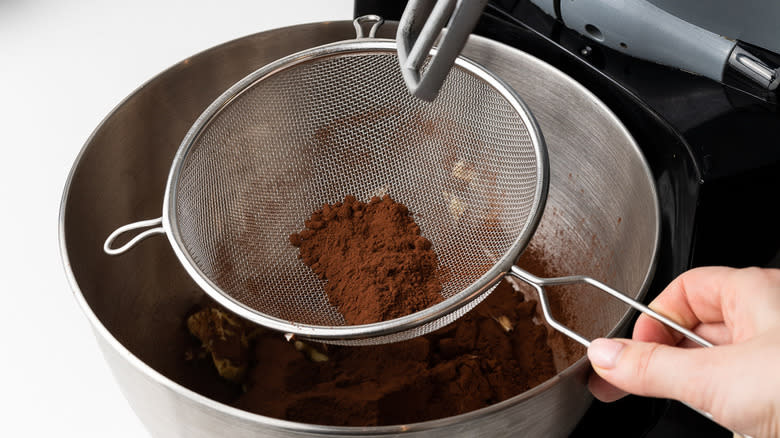What's The Best Type Of Cocoa Powder For Chocolate Buttercream?

The world loves cocoa, no doubt about that. With global cocoa production reaching millions of tons every year, a lot of that ends up as cocoa powder for cooking and hot-chocolate sipping. One place it really shines is in chocolate buttercream, where your choice of cocoa powder really matters. It's a front-and-center ingredient that can make or break the purity and flavor depth of buttercream, and it all comes down to the butterfat content.
Cocoa powder is a highly concentrated version of chocolate in which cocoa butter has largely been removed from the roasted cocoa beans. However, a small amount of cocoa butter remains in the beans after they've been pressed and ground into powder, and that's the magic fat percentage you're looking for. It's what distinguishes the available types of cocoa powder for mixing into your buttercream cupcake frostings, fillings, thumbprint cookies, and macarons. In general, the fat content of cocoa powder ranges from 10% to 24%. The higher the butterfat percentage, the richer and more flavorful the chocolate buttercream.
It's important to note that anything labeled as drinking cocoa, cocoa powder mix, or hot cocoa mix is not what you want for a rich chocolate frosting recipe. Avoid these packets or tins, as they're highly likely to contain other ingredients, such as sugar, flavorings, and milk solids. These mixes will basically ruin the pure taste and creamy consistency of a genuine chocolate buttercream. You'll instead be looking for a high-fat cocoa powder such as Dutch-processed.
Read more: 25 Chocolate Brands, Ranked Worst To Best
Making Buttercream The Dutch Way

Several types of cocoa powder have middle-to-high percentages of butterfat, including what's referred to as natural or unsweetened cocoa powder. This natural cocoa works well in many types of baking, but since it's unprocessed after being powdered, there's generally a sharper, more acidic taste than with processed cocoa powders. That's where Dutch processing enters the picture.
The difference between Dutch-process and natural cocoa powder is that the Dutch-processed cocoa powder has been alkalized to lower acidity. This provides a deeper, smoother flavor that's more earthy and intense, which is an excellent quality when making chocolate buttercream. Within the Dutch-process category, additional levels exist, including double-Dutch, Bensdorp, and rouge, also called red or burgundy, as well as mixtures that incorporate several kinds. With the elevated butterfat percentages and the Dutch qualities in taste and texture, these are all fine options for buttercream.
To find these alkalized cocoa powders, keep an eye out for the term Dutch-process somewhere on the label. They sometimes also identify as European-style cocoa. Though U.S. cocoa powder brands such as Hershey's don't typically go through the Dutch process, there is an exception. The Hershey's Special Dark product is presented as a "Dutched cocoa."
Read the original article on Tasting Table

